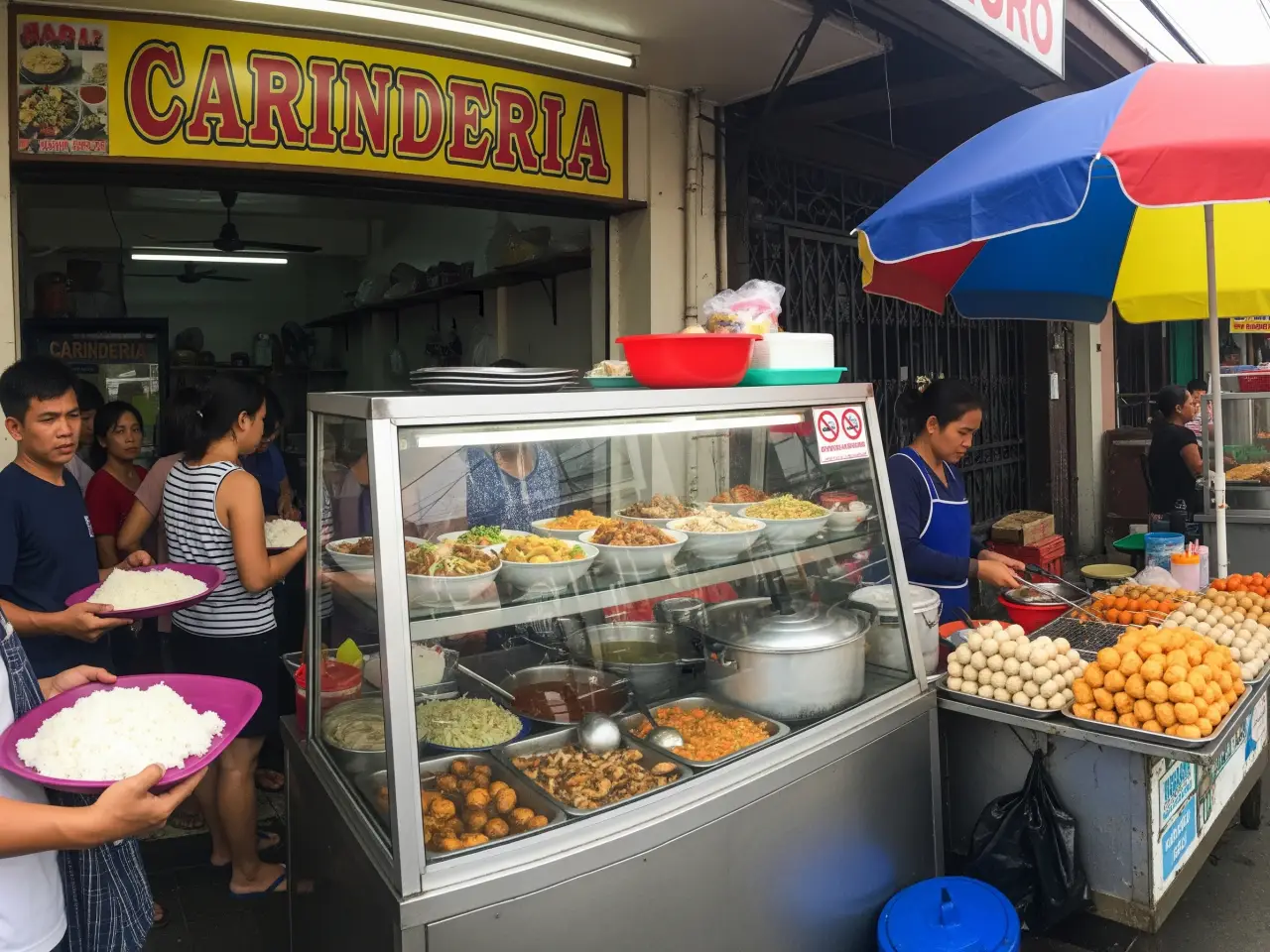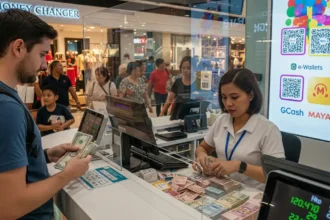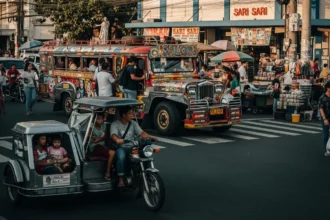✨ Eating Like a True Filipino Traveler
Picture this: You just landed in Manila or maybe you’re on a long bus ride to the province. Gutom ka na, but you don’t want to spend ₱300–₱500 on some fancy restaurant meal. Here’s the secret — you don’t have to.
- ✨ Eating Like a True Filipino Traveler
- 🍛 What Exactly Is a Carinderia?
- 🍢 Street Food: The Flavor of Filipino Streets
- 💸 Carinderia vs Fast Food vs Restaurant: A Cost Comparison
- 🥄 How to Order Like a Local (Without Looking Lost)
- 🧾 Sample ₱200/Day Food Budget
- 🛑 Hygiene & Safety Tips for Travelers
- 🌍 Why Eating Like a Local Is More Than Just Saving Money
- 📚 Frequently Asked Questions
- ❤️ More Than Food, It’s Home
In the Philippines, the cheapest, tastiest, and most authentic meals aren’t found in malls or hotels. They’re in the humble carinderias and at street corners where vendors sell snacks sizzling in hot oil. Eating like a local isn’t just a budget move — it’s a cultural experience. And if you’re smart about it, you can eat well on just a couple of hundred pesos a day.
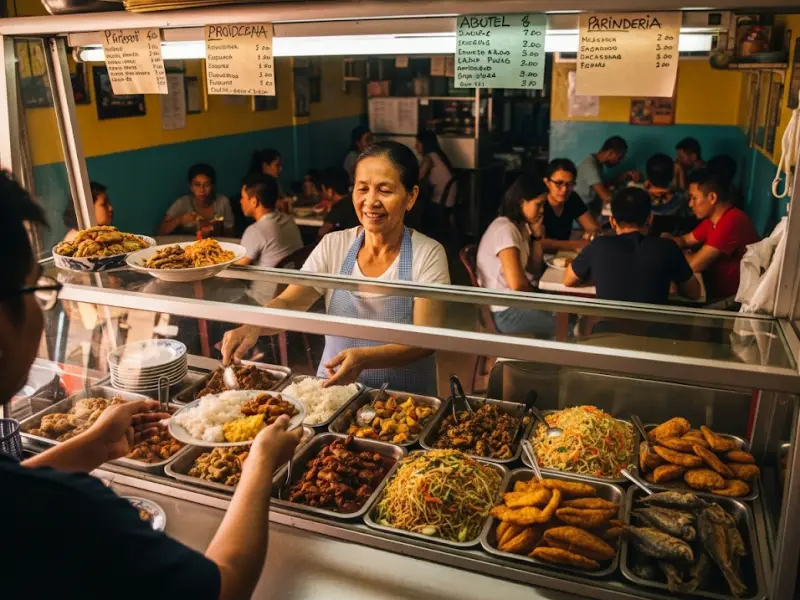
🍛 What Exactly Is a Carinderia?
If you’ve never stepped into one, a carinderia (also called turo-turo) is basically the Philippines’ answer to the neighborhood diner — only way cheaper and homier. The name turo-turo literally means “point-point,” because that’s exactly how you order: you walk up to a glass display of dishes, point at what looks good, and the ate behind the counter heaps it onto your plate with rice.
It’s food stripped of pretense — no glossy menus, no fancy plating, just real Filipino cooking served fast and hot.
What’s on the Menu?
Carinderias usually rotate a lineup of everyday Filipino comfort food:
-
Adobo – the national dish, meat stewed in soy sauce, vinegar, garlic.
-
Menudo or Afritada – tomato-based stews with pork, potatoes, and veggies.
-
Sinigang – a tangy soup soured with tamarind, perfect on a rainy day.
-
Gulay – sautéed vegetables like ginisang sayote or pinakbet with bagoong.
-
Fried staples – crispy tilapia, bangus, or fried chicken fresh from the wok.
Some carinderias even throw in regional specialties — Bicol express in Albay, laing in Naga, or pancit variations depending on the province.
The Price Tag
This is where carinderias shine.
-
A plate of rice + one ulam? ₱50–₱80.
-
Add another ulam and you’re still under ₱120.
-
Order the same at a fast food chain and you’ll easily drop ₱250–₱350.
That price difference adds up fast, especially if you’re traveling or eating out every day.
The Vibe
Eating at a carinderia isn’t just about saving money — it’s about soaking in everyday Filipino life.
-
You’ll see jeepney drivers wolfing down a quick meal before their next route.
-
Students huddled around a table, stretching their allowance.
-
Office workers, construction crews, titas in dusters — all sitting shoulder-to-shoulder.
It’s a true equalizer: everyone’s there for the same reason — affordable, filling, no-nonsense food that tastes like home. And if you’re lucky, the nanay running the carinderia might even sneak in extra sabaw (soup) or an extra scoop of rice if she likes you.
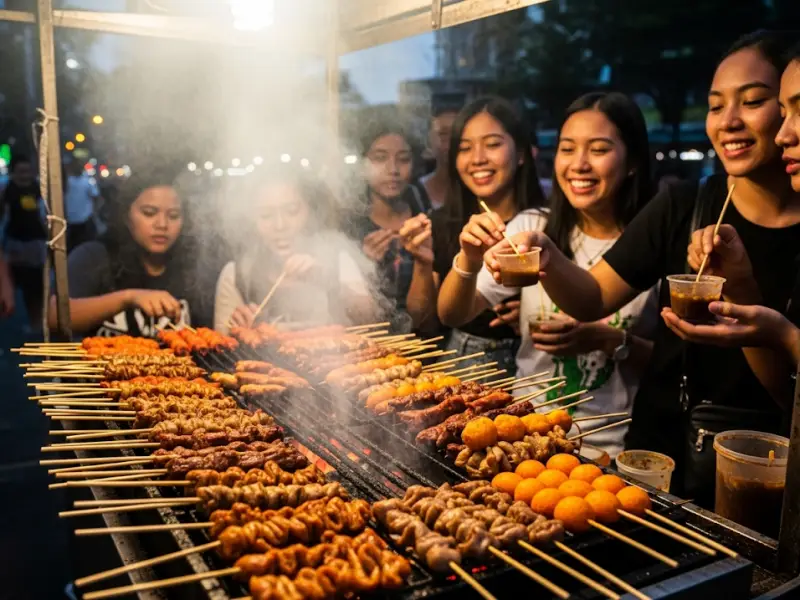
🍢 Street Food: The Flavor of Filipino Streets
No guide to eating like a local is complete without street food. This is where the Philippines truly shines — cheap, tasty, and always a little adventure. Whether you’re in the city or a small town, you’ll spot food carts parked by schools, markets, or street corners, calling you in with the smell of frying oil and barbecue smoke.
The Classics You Can’t Miss
-
Fishballs – The OG street snack. Skewered, fried, then dunked in your choice of sweet, spicy, or vinegar sauce. Just ₱5–₱10 can keep you munching while you chat with the manong vendor.
-
Kwek-kwek – Quail eggs in that iconic bright-orange batter, deep-fried until crisp. Usually around ₱20–₱30 a serving. Pair it with spicy vinegar for the full kick.
-
Isaw – Grilled chicken or pork intestines, smoky, chewy, and surprisingly addictive. A stick costs only ₱10–₱20, making it one of the cheapest BBQ fixes you’ll ever have.
-
Banana cue / Turon – Fried plantains or bananas wrapped in lumpia wrapper, coated in caramelized sugar. At ₱15–₱20, they’re the ultimate merienda pang-bahay brought straight to the street.
-
Balut – The infamous fertilized duck egg. Some say it’s a dare, but locals see it as comfort food. For ₱20–₱30, you get protein, broth, and a crash course in Filipino food culture.
More Than Just Snacks
Street food isn’t just about filling your stomach — it’s a social ritual.
-
You stand around the cart, dip your fishballs into the communal sauce jar, and swap stories with friends, co-workers, or even strangers.
-
In the provinces, street food carts often double as neighborhood hangouts, where kids spend their spare coins and adults unwind after work.
-
It’s quick, it’s cheap, and it connects you to the everyday rhythm of Filipino life.
A Few Quick Tips for First-Timers
-
Look for busy stalls — high turnover means fresher food.
-
Watch the cooking — go for vendors who fry or grill on the spot, not those with snacks sitting out too long.
-
Bring coins and small bills — most street vendors don’t carry change.
-
Don’t be shy — half the fun is chatting with the vendor and fellow eaters while you snack.
Eating street food is less about the peso value and more about the experience: smoky air, clinking skewers, and laughter around a tiny cart. That’s what makes it authentically Pinoy.
💸 Carinderia vs Fast Food vs Restaurant: A Cost Comparison
Let’s put it into perspective:
| Meal Option | Average Cost (per person) | Experience |
|---|---|---|
| Carinderia | ₱50 – ₱120 | Home-style, filling, local vibe |
| Street Food (snack) | ₱10 – ₱40 | Quick bites, communal, fun |
| Fast Food (Jollibee, McDo) | ₱150 – ₱250 | Consistent, but processed |
| Restaurant / Café | ₱250 – ₱500+ | Comfort, ambiance, tourist-friendly |
👉 Verdict: If you’re on a budget (or want authentic flavors), carinderias + street food win hands down.
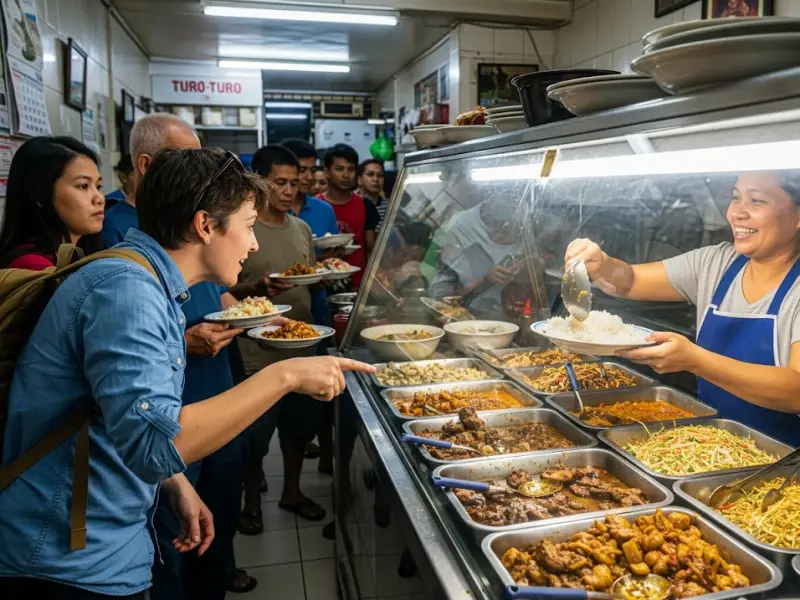
🥄 How to Order Like a Local (Without Looking Lost)
Walking into a carinderia for the first time can feel like stepping into organized chaos: trays of steaming food, people pointing left and right, ate behind the counter moving like lightning. Don’t panic — here’s your crash course in ordering like a pro.
Step-by-Step Carinderia Survival Guide
-
Grab a Tray or Plate
Usually, ate will hand you one when you line up. Some spots have plates stacked at the counter, so just grab and wait your turn. -
Point at Your Ulam (Turo-Turo Style)
The magic word is “turo” (point). Don’t worry if you don’t know the name of the dish — just point and say:“Isa pong adobo, tsaka extra rice please.”
If you want to sound more local:
“Adobo po, tapos dagdag kanin.” -
Ask for Sabaw (Soup)
Many carinderias will give you free broth from nilaga or sinigang if you ask nicely. Just say:“Pahingi po ng sabaw.”
Perfect for stretching your rice and adding flavor. -
Eat First, Pay Later
In most carinderias, you settle the bill at the counter after you eat. Don’t stress about keeping track — ate will remember what you ordered (she has powers). -
Self-Service Water
There’s usually a big pitcher of drinking water or a blue jug in the corner. Just grab a glass and help yourself. -
Pro (and Humor) Tip: Extra Rice
Always check if “extra rice” is unlimited. If it is, jackpot ka na — you’ve officially found heaven on earth for rice lovers.
Bonus Hacks to Blend In
-
Sit wherever — don’t wait to be seated. Just find an empty spot, even if it means sharing a table with strangers (totally normal).
-
Use a spoon and fork — Filipinos rarely use knives; spoon in the right hand, fork in the left.
-
Smile at ate — friendliness goes a long way; she might sneak you a bigger serving.
Ordering at a carinderia isn’t just about getting food — it’s about embracing the flow. Once you’ve survived your first round of turo-turo, you’re officially eating like a local.
🧾 Sample ₱200/Day Food Budget
Here’s how you can comfortably eat like a local for a day under ₱200:
| Meal | Food Choice | Cost |
|---|---|---|
| Breakfast | Pandesal + instant coffee | ₱30 |
| Lunch | Rice + adobo + gulay (carinderia) | ₱70 |
| Snack | 5 sticks of isaw + turon | ₱30 |
| Dinner | Rice + sinigang (carinderia) | ₱70 |
| Total | ₱200 |
Compare that to spending ₱600–₱800 at malls or restos for the same three meals + snacks. Sulit, diba?
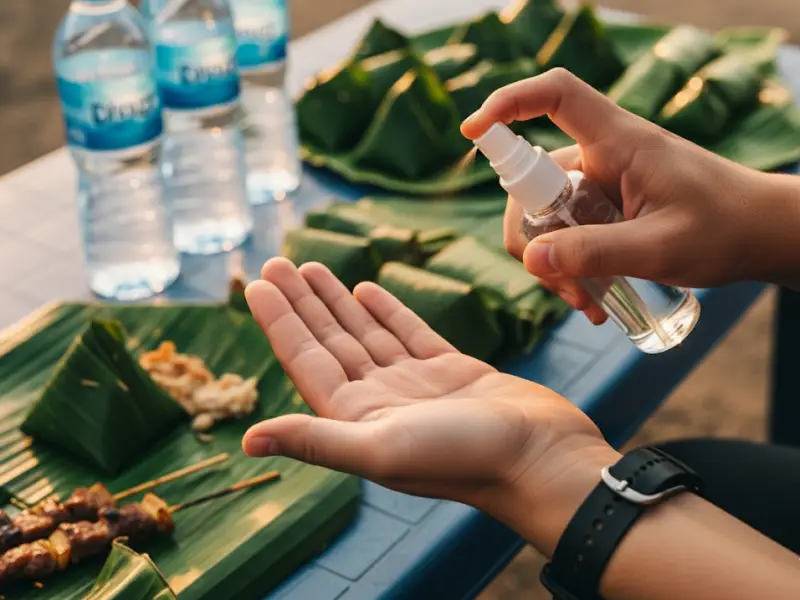
🛑 Hygiene & Safety Tips for Travelers
Food is half the fun of exploring the Philippines, but let’s be real — montezuma’s revenge (a.k.a. tummy troubles) is never on the itinerary. Whether you’re a foreigner or a local with a sensitive stomach, these simple habits will keep you safe while still letting you enjoy carinderias and street food like a pro.
Quick Rules to Eat Smart & Stay Safe
-
Choose Busy Stalls
If the line is long and the trays empty fast, that’s a good sign. High turnover = fresh food that hasn’t been sitting around too long. -
Eat What’s Cooked in Front of You
Especially for street food, go for snacks pulled fresh from the fryer or grill. That’s your best defense against tummy issues. Lukewarm is risky — sizzling is safe. -
Check the Setup
You don’t need hotel-level cleanliness, but plates, utensils, and stalls should look reasonably washed and organized. If the flies are having a party, maybe skip that one. -
Avoid Tap Water
Even locals sometimes avoid it. Stick to bottled, refilled, or filtered water. Most hostels, cafés, and restaurants now offer refill stations, so bring that reusable bottle. -
Bring Wipes & Alcohol
Filipino travelers swear by wet wipes and rubbing alcohol (or hand sanitizer) — not just for hands, but for wiping down utensils or tables if needed. -
Trust Your Gut (Literally)
If it smells funky, looks off, or you’re hesitant — skip it. Don’t feel pressured to try every exotic bite. There’s always another delicious (and safer) option around the corner.
Extra Tips for Foreigners
-
Start small with street food — try fishballs and banana cue before jumping straight to isaw or balut.
-
Ask locals what’s safe in the area. Vendors serving students and office workers daily are usually reliable.
-
Keep some charcoal tablets or over-the-counter meds handy — just in case your stomach needs backup.
Eating local is about adventure, but adventure doesn’t have to mean regret at 2 AM. Follow these tips and you’ll enjoy all the flavors without the food coma side effects.
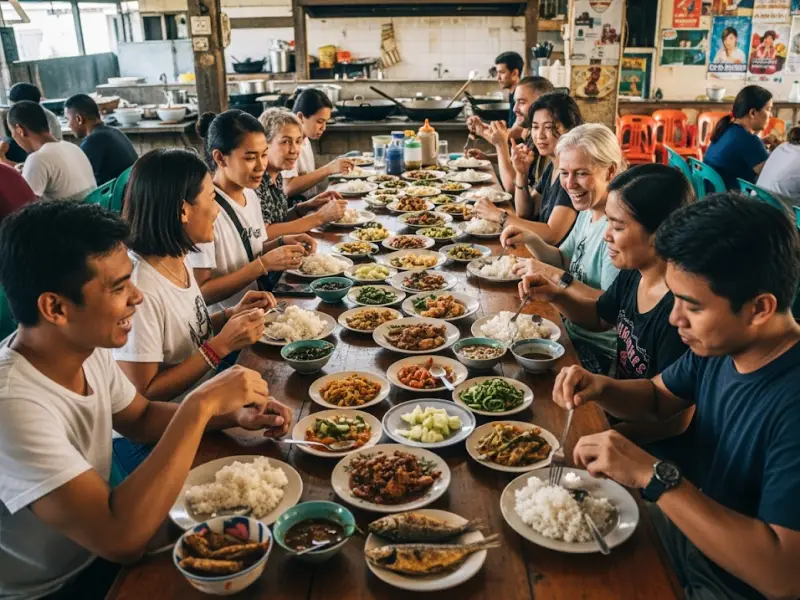
🌍 Why Eating Like a Local Is More Than Just Saving Money
Yes, carinderias and street food stalls are budget-friendly, but if you stop there, you miss the point. The real magic is in the experience — the cultural connection you get for the price of a humble plate of rice.
When you eat like a local:
-
You sit shoulder to shoulder with strangers who feel like neighbors by the end of the meal.
-
You taste recipes passed down from one generation to the next, cooked not for tourists but for the people who live and breathe them every day.
-
You experience pakikisama — that uniquely Filipino sense of belonging, of being welcomed into the everyday rhythm of community life.
I still remember eating in a small carinderia in Cebu. The owner served me an extra scoop of rice and a steaming bowl of free soup, then sat down to ask about my trip. That simple gesture, that short conversation, felt warmer and more genuine than any polished service I’ve had in a 5-star hotel.
That’s the beauty of eating local: it’s not just about stretching your peso, it’s about stretching your heart and opening yourself up to real human connection. Carinderias and street stalls aren’t just food stops — they’re windows into the soul of Filipino culture.
📚 Frequently Asked Questions
Is it safe for foreigners to eat at carinderias?
Yes, especially if you stick to busy ones where food turnover is fast.
Do carinderias serve vegetarian meals?
Some do (like ginisang gulay, mongo). But meat is common, so vegetarians need to ask.
Can I get halal food at a carinderia?
In Muslim areas (Mindanao, Quiapo), halal carinderias exist. Best to ask locals.
How do I say “extra rice” in Tagalog?
Just say “extra rice po” — Filipinos will instantly understand.
Is it okay to haggle at carinderias?
No, prices are already cheap. Haggling is not common.
Do Filipinos really eat like this every day?
Yes, millions of workers, students, and travelers rely on carinderias daily.
What’s the average carinderia meal cost in 2025?
Around ₱70–₱100 per plate with rice and one ulam.
Do I pay before or after eating?
Usually after eating, but some carinderias (especially in malls/food courts) ask before.
Are there carinderias in big cities like Manila and Cebu?
Yes, everywhere — from busy streets to neighborhood corners.
What’s the must-try street food for first-timers?
Fishballs and kwek-kwek — cheap, fun, and iconic.
❤️ More Than Food, It’s Home
When you eat at a carinderia or grab street food on the corner, you’re not just filling your stomach. You’re stepping into the heartbeat of Filipino daily life.
It’s the jeepney driver sipping sabaw after a long shift. The students sharing one big plate of pancit. The vendor who remembers your order after two visits.
Food in the Philippines isn’t just about eating — it’s about community. And if you really want to know a place, don’t just visit the tourist spots. Sit down at a plastic table, eat with your hands, laugh with strangers, and taste the Philippines the way Filipinos live it every day.
Because at the end of the day, eating like a local isn’t just cheap — it’s priceless.



